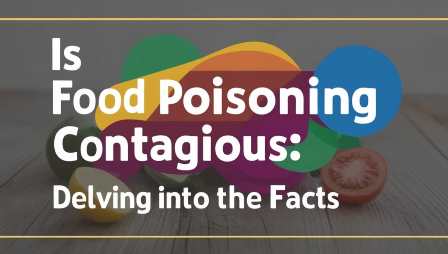Is food poisoning contagious? It’s the Million-Dollar Question, and the answer isn’t as simple as reheating leftovers. Food poisoning, unlike the ordinary cold or flu, is not often infectious in the sense that it spreads from person to person. However, some nuances do occur!
Is food poisoning contagious? This question serves as a beacon, leading us through the maze of infections, their means of transmission, and the outliers that defy the norm.
Is food poisoning contagious? The definitive answer is not a simple yes or no, but rather a complicated investigation of the complexities of infectious agents, their actions, and the safeguards that protect us from their effects.
Food poisoning is rarely transmitted directly from one person to another. You won’t get it via shaking hands or being around someone who has it, unless… (More on that shortly!)
Exceptions: Certain viruses, such as norovirus or hepatitis A, can transmit foodborne illnesses from person to person. These viruses flourish in polluted food or water and can be transmitted by intimate contact with an infected person or by sharing belongings.
Exceptions revealed: infectious culprits.
There are rare exceptions to the widely held belief that food poisoning is not communicable. Does this suggest that food poisoning is contagious? True:
Norovirus is the infectious cause.
This iconic virus exemplifies an exception to the non-infectious nature of food poisoning. People can transmit the norovirus, known for causing outbreaks on cruise ships and in crowded areas, from one person to another. Intimate contact with an infected person or consuming contaminated food or water can transmit the virus, which thrives on surfaces and in food.
Food poisoning, a term that refers to a variety of disorders caused by consuming contaminated food, is a worldwide concern. One frequently asked topic about foodborne infections is whether or not food poisoning is contagious. Understanding the transmission and infectious nature of foodborne diseases is critical for mitigating their spread and protecting public health.
Define food poisoning.
Consuming contaminated food or beverages can lead to food poisoning. These pollutants include bacteria, viruses, parasites, poisons, and chemicals.
Common symptoms include nausea, vomiting, diarrhea, stomach pain, and fever, which typically appear within hours or days of consuming infected food.
The spread of food poisoning
Ingestion of contaminated food or beverages most commonly transmits food poisoning. Food poisoning, unlike illnesses such as the common cold or flu, does not spread directly or from person to person via casual touch or air.
Infectious components of food poisoning
Despite the traditional belief that food poisoning is not as communicable as the flu or a cold, it can spread among individuals. Pathogens like norovirus or salmonella, shed in feces and vomit, can spread the disease through direct contact with sick individuals or surfaces contaminated with their bodily fluids.
Causes of Food Poisoning:
Bacteria include Salmonella, E. coli, and Campylobacter; viruses include Norovirus and Hepatitis A.
Giardia and Cryptosporidium are parasites. Bacteria such as Staphylococcus aureus and Clostridium botulinum produce toxins (poisons).
There are numerous microorganisms capable of causing food poisoning, each with its own route of transmission.
Some common culprits are:
Bacteria: E. coli, Salmonella, and Listeria are common pathogens that contaminate food owing to inappropriate handling, storage, or cooking. Ingestion of these germs can lead to serious disease.
Viruses such as norovirus and hepatitis A can cause foodborne diseases. Contaminated food or water may contain these viruses, and contact with infected people or surfaces can transmit them.
Parasites: Parasites like Giardia and Cryptosporidium can contaminate food or water, causing gastrointestinal issues when consumed.
Toxins: Bacteria like Clostridium botulinum produce toxins that can contaminate food and cause botulism. Consuming such hazardous substances can lead to serious sickness.
Symptoms:
Norovirus causes severe vomiting, diarrhea, and stomach cramps, and, in rare cases, fever, causing victims to suffer great and quick discomfort.
Its high infectiousness makes it a formidable foe, necessitating strict cleanliness standards and isolation of affected individuals to avoid further spread.
Hepatitis A is another infectious invader.
Hepatitis A, albeit less common, is another foodborne infection that bucks the trend. Ingestion of contaminated food or water can transmit it from person to person.
Hepatitis A damages the liver and causes fatigue, nausea, jaundice (yellowing of the skin and eyes), stomach discomfort, and fever.
Transmission: Ingestion of feces, typically contaminated food or drink, disseminates the virus, raising concerns about contagion.
Preventive Measures
You can take a number of preventive measures to reduce the risk of food poisoning.
Food safety practices include proper food handling, storage, and cooking processes, which dramatically lower the danger of contamination. This includes thoroughly washing hands,
segregating raw and cooked foods, and cooking at acceptable temperatures.
Hygiene: Good hygiene is essential, especially among food workers, to avoid the spread of foodborne infections.
Food Inspection and Regulation: To decrease the danger of contamination, food establishments must undergo regular inspections and conform to food safety rules.
Public awareness and education: Educating the public about safe eating practices and the dangers of mishandling food can assist in lowering the incidence of food poisoning.
FAQ: Decoding Common Questions
To further illuminate this fascinating topic, let’s examine some frequently asked questions regarding the contagiousness of food illnesses.
1. Can you contract food poisoning from someone who has it?
In most circumstances, food poisoning does not spread directly from one person to another. However, contaminated food, water, or close contact with an infected person can transmit certain viruses like norovirus and hepatitis A.
2. How long does food poisoning take to spread?
The onset of symptoms associated with food poisoning can vary depending on the causal reason. Some germs can induce symptoms within a few hours, while others can take many days to manifest. Viral infections, such as norovirus, frequently produce symptoms within 12–48 hours following contact.
3. What are the best ways to prevent food poisoning?
To avoid food poisoning, maintain excellent food hygiene:
Before touching any food, properly wash your hands. Cook foods thoroughly, particularly meat.To avoid cross-contamination, keep raw and cooked food products apart.Store food at the proper temperature.
4. Can I transmit food poisoning once I’ve recovered?
Even after symptoms have subsided, people may continue to discharge the virus or bacteria that cause food poisoning for several days or weeks. To avoid the spread of the virus, it is critical to practice excellent hygiene at this time.
5. At what point should I seek expert aid if I fear food poisoning?
Seek medical assistance if your symptoms are severe or persistent, or if you suspect contamination from a high-risk source (for example, undercooked meat or polluted water). Dehydration or symptoms of a serious illness should also urge medical attention.
6. Is food poisoning contagious?
Food poisoning typically does not spread from person to person, but contaminated food, water, or close contact with an infected individual can spread some illnesses like norovirus and hepatitis A.
7. What’s the cause of food poisoning?
Bacteria like Salmonella and E. coli, viruses like Norovirus and Hepatitis A, parasites like Giardia, or bacteria-produced toxins like Clostridium botulinum can all cause food poisoning.
8. What are some frequent signs of food poisoning?
Symptoms may include nausea, vomiting, diarrhea, stomach pain, fever, and muscle aches. They can differ depending on the exact pollutant.
9. How long do food poisoning symptoms take to appear?
Symptoms might appear within hours or days, depending on the causative substance. Some infections, such as norovirus, produce symptoms within 12–48 hours, although others may take longer.
10. Can you contract food poisoning from someone who has it?
Direct transmission of food poisoning is rare. However, certain illnesses can spread by contact with contaminated surfaces, items, or diseased people.
11. How is food poisoning diagnosed?
To identify the precise infection responsible, doctors frequently examine symptoms, medical histories, and, in some cases, laboratory tests.
12. How long does food sickness usually last?
The length varies depending on the causative substance and the individual’s health. Symptoms might continue from a few hours to several days and may necessitate medical intervention in extreme situations.
In summary, contaminated foods and beverages primarily transmit food poisoning, but the infectiousness of each pathogen varies. Some pathogens, despite not spreading like typical diseases, can still spread through contact with infected individuals or contaminated surfaces. Understanding the sources, preventive measures, and how it spreads is critical for preventing foodborne infections and protecting public health.

